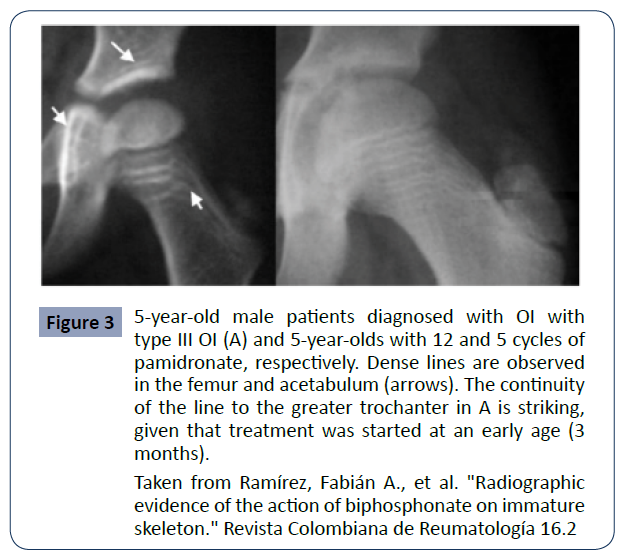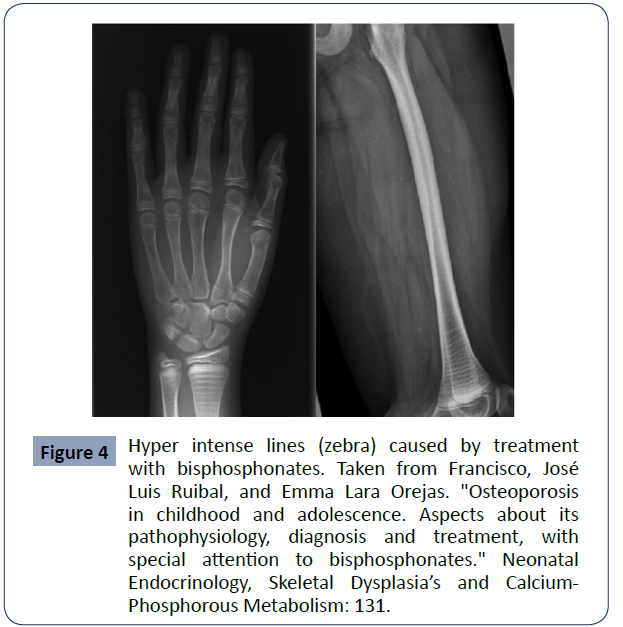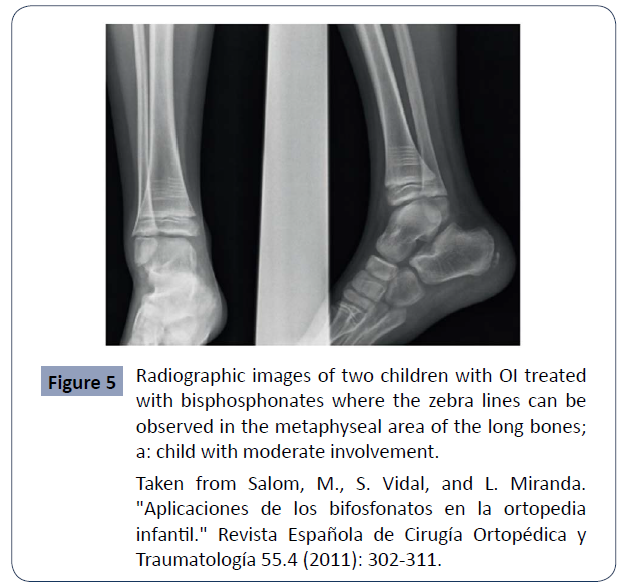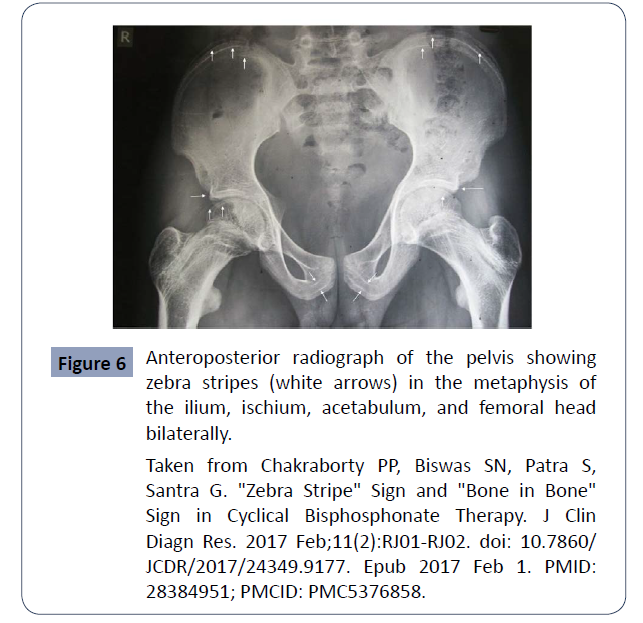Review Article - (2022) Volume 0, Issue 0
Zebra Lines Sign: Marker of Biphosphonates Use
Eduardo Andres Rayon Reyes
Radiology Resident, Pontificia Universidad Catolica do Rio de Janeiro, Brasil
General Physician, Universidad Cooperativa de Colombia, Santa Marta, Colombia
General Physician, Universidad del Magdalena, Santa Marta, Colombia
General Physician, Fundacion Universitaria Ciencias de la Salud, Bogota, Colombia
General Physician, Universidad UTE, Quito, Ecuador
General Physician, Universidad de Boyaca, Colombia
General Physician, Universidad Autónoma de Bucaramanga, Colombia
General Physician, Universidad de Santander UDES, Colombia
*Correspondence:
Andres Felipe Diaz Munoz, Radiology Resident, Pontificia Universidad Catolica do Rio de Janeiro,
Brasil,
Email:
Received: 11-Mar-2022, Manuscript No. Iphsj-22-12658;
Editor assigned: 13-Mar-2022, Pre QC No. PreQc No. Iphsj-22-12657(PQ);
Reviewed: 27-Mar-2022, QC No. QC No. Q-12657;
Revised: 01-Apr-2022, Manuscript No. Iphsj-22-12658(R);
Published:
09-Apr-2022, DOI: 10.36648/1791-809X.16.S6.923
Abstract
Bisphosphonates or bisphosphonates are a group of medications used for the prevention and treatment of diseases with bone resorption such as osteoporosis, causing positive impacts, among these is the significant decrease in possible fractures in this population in question, however, the use of these chemical compounds in patients, especially with an immature skeleton, has caused peculiar manifestations known as zebra lines, which appear as linear bands parallel to the hyper dense growth plate, radio opaque, and visible radio logically, reason why which has been considered a marker of the use of bisphosphonates.
Keywords
Orthopaedics, Zebra line, Bisphosphonate, Pediatrics
Introduction
Bisphosphonates or known by their acronym as BF, are synthetic analogous compounds of the endogenous pyrophosphate molecule, in which the P-O-P structure has been modified by the P-C-P; and the presence of this double phosphonic group gives it particular resistance to hydrolysis Figure 1 [1]. Among their important characteristics, these compounds have the ability to regulate bone metabolism, joining the hydroxyapatite of the mineralized matrix, remaining in the skeleton for a long time, exerting their antiresorptive activity, in other words, they are chemicals whose main action on bone metabolism is the inhibition of bone resorption, for this reason, the use of bisphosphonates in the skeleton, especially in immature stages, has meant a great advance in the management of certain bone metabolic diseases, as is the case of osteogenesis imperfecta but it can also be administered in other pathologies that present with increased bone resorption, improving its clinical course and reducing the appearance of fractures [2]. These drugs can be classified according to their chemical structure and route of administration as shown in figure 2, according to their chemical structure and administration life. (Figure 1)
Figure 1 Chemical formula of bisphosphonates.
Figure 2 Classification of bisphosphonates.
As mentioned, bisphosphonates are very useful drugs in the treatment of certain metabolic bone diseases. They are drugs used in the treatment of various pathologies such as multiple myeloma, bone metastases and malignant hyperkalemia, as well as in the prevention and treatment of diseases of the skeletal system, such as Paget's disease and especially osteoporosis [3, 4]. However, it is true that its prolonged use can have a somewhat negative impact on the body, generating adverse effects that are mentioned later (Figure2).
The side effects found and caused by bisphosphonates in patients, especially in children, have been described acute phase reactions that occur after the first intravenous administration of the drug and that resembles a flu, the most frequent are side effects related to the upper digestive system, such as gastric erosions and ulcers, among other effects observed in (Table 1) [5,6].
| Upper digestive apparatus |
Nausea, erosions and gastric ulcers, also describing some cases of esophagitis and oesophageal strictures |
| Cardiovascular system |
May cause fever, flu-like symptoms,
administration site and kidney abnormalities, in addition, in the long term it can cause atrial fibrillation |
| Musculoskeletal system |
Osteonecrosis of the jaws, atypical fractures, musculoskeletal pain and zebra line sign |
| Ocular system |
They can induce inflammatory eye disorders: conjunctivitis, episcleritis and uveitis. |
Table 1. Main adverse effects of prolonged use of bisphosphonates in specific areas of the body.
Among the side effects after the administration of bisphosphonates there is a sign called the zebra line, which, although it is very important to know, has no clinical significance, so it is rarely described. However, its presence can cause confusion, so it should be known by the radiologist [7]. The zebra lines correspond to the appearance of high-density linear bands located in the metaphysical zone of the bones, parallel to the growth cartilage, which can be evidenced in the radiological study of the limbs, each line corresponds to a treatment cycle, these they are formed from calcified cartilage that is not reabsorbed by the action of BF and calcified bone, causing these lines to move away from the growth plate in the long term, thus demonstrating that bone growth does not stop despite treatment [8]. The appearance of these lines is generally the consequence that is seen in Pediatric patients, because in this population the bone or skeleton system is immature, therefore, children who receive treatment with bisphosphonate, the radiological pattern "Line of zebra” is usually a marker of the use of this type of drug [9].
Results
After applying the search strategies in the different databases, around 27 references were obtained. Reading through we found that bisphosphonates have been used for many years for thetreatment of osteoporosis, multiple myeloma, Paget's disease, as well as a variety of other diseases in which there is reduced bone mineral density [10]. As indicated by the results of Molvik et al. Patients with distal radius fractures on bisphosphonates had a significantly longer union time compared to controls, but patients with femoral fractures did not [11 ]. Bisphosphonates are chemically stable analogs of pyrophosphate compounds, which have been used to treat multiple disorders of calcium metabolism given their clear affinity for OHA, BPs tend to accumulate in bone areas subject to remodelling, because in this phase OHA lacks of the sheath of connective tissue and cells that normally covers it. For this reason, BPs tend to preferentially deposit in bone areas that are subject to the most important turnover events, particularly those areas that suffer from inflammation and inflammatory processes resulting from the localized production of numerous inflammatory processes [12]. As in the case of a patient with pachydermoperiostosis, in whom the applied treatments did not cause improvement, until the application of bisphosphonates, with which they had encouraging results, so Jagdish et al. suggest that parenteral bisphosphonates should be tried early in the treatment of pachydermoperiostosis [13]. As well as, in other pathologies such as multifocal epithelioid bone hemangioma (EH) where the authors observed that it responded favorably to intravenous Zometa with an improvement in bone metabolic markers. After 1 year of follow-up, the patient was well without significant pain, thus suggesting that bisphosphonates should be considered in the treatment of multifocal osteocytes bone HE [14]. It is also used as a treatment for idiopathic juvenile osteoporosis and osteogenesis imperfecta. This is evident by the appearance of lines at the proximal end of the femur, converging from the proximal capital physis, continuing along the upper border of the neck to the physis of the greater trochanter, following the old common growth plate. The lines outlined in this way, parallelly outlining the growth plates (physis), give an appearance on radiographs of "zebra lines" as shown in Figure 3. These lines correspond to momentary imbalances in bone turnover (Figure 3) [15].
Figure 3 5-year-old male patients diagnosed with OI with type III OI (A) and 5-year-olds with 12 and 5 cycles of pamidronate, respectively. Dense lines are observed in the femur and acetabulum (arrows). The continuity of the line to the greater trochanter in A is striking, given that treatment was started at an early age (3 months).
Taken from Ramirez, Fabia¡n A., et al. "Radiographic evidence of the action of biphosphonate on immature skeleton." Revista Colombiana de ReumatologÃÃÃÂ???Âa 16.2
We understand bisphosphonates as drugs that inhibit osteoplastic activity, favouring its apoptosis, thus increasing bone mass by altering the balance between bone formation and resorption. Other studies report that, regardless of the route of administration used, the appearance of parallel metaphyseal sclerotic lines called zebra lines, which have no consequences, is characteristic in bone X-rays. They are related to each administration of the drug and disappear with bone remodelling, as shown in (Figure 4) [16].
Figure 4 Hyper intense lines (zebra) caused by treatment with bisphosphonates. Taken from Francisco, JosÃÃÃÂ???© Luis Ruibal, and Emma Lara Orejas. "Osteoporosis in childhood and adolescence. Aspects about its pathophysiology, diagnosis and treatment, with special attention to bisphosphonates." Neonatal Endocrinology, Skeletal Dysplasiaâ??s and Calcium- Phosphorous Metabolism: 131.
The application of bisphosphonates extends to Pediatric Orthopaedics due to the fact that in the radiographic controls of children treated with this component, zebra lines can be observed, which correspond to dense metaphysical lines parallel to the growth plate. Each line corresponds to a treatment cycle. They are formed from calcified cartilage that is not reabsorbed by the action of BF and calcified bone. These lines move away from the growth plate over time, showing that bone growth does not stop despite treatment (Figure 5) [17].
Figure 5 Radiographic images of two children with OI treated with bisphosphonates where the zebra lines can be observed in the metaphyseal area of the long bones; a: child with moderate involvement.
Taken from Salom, M., S. Vidal, and L. Miranda. "Aplicaciones de los bifosfonatos en la ortopedia infantil." Revista Española de Cirugía Ortopédica y Traumatología 55.4 (2011): 302-311.
With the expanding use of bisphosphonates in a broad spectrum of Pediatric skeletal disorders, clinicians should be familiar with the expected bone imaging changes associated with the use of this agent, evidenced in the case of a a 15-year-old boy with a history of multiple long-bone fragility fractures since early childhood and later diagnosed with juvenile osteoporosis, for which he had been prescribed oral calcium, cholecalciferol, and intravenous zoledronate to mitigate increased bone fragility and associated musculoskeletal symptoms. Skeletal radiological examination revealed transverse sclerotic bands (maximum three in number, corresponding to the number of bisphosphonate doses received) in the metaphysis of the femur, proximal tibia, proximal fibula, ilium, ischial tuberosities, acetabulum, radius, distal ulna, metacarpals, phalanges and vertebral bodies, analogous to the striped appearance of a zebra. The “zebra stripe” sign is a radiological manifestation of cyclic bisphosphonate therapy prior to closure of the epiphyseal growth plates and is seen in approximately half of users (Figure 6) [18].
Figure 6 Anteroposterior radiograph of the pelvis showing zebra stripes (white arrows) in the metaphysis of the ilium, ischium, acetabulum, and femoral head bilaterally.
Taken from Chakraborty PP, Biswas SN, Patra S, Santra G. "Zebra Stripe" Sign and "Bone in Bone" Sign in Cyclical Bisphosphonate Therapy. J Clin Diagn Res. 2017 Feb;11(2):RJ01-RJ02. doi: 10.7860/JCDR/2017/24349.9177. Epub 2017 Feb 1. PMID: 28384951; PMCID: PMC5376858.
Zebra lines are metaphyseal bands of increased density seen near the ends of long bones during cyclic bisphosphonate therapy in osteogenesis imperfecta. They are most prominently seen around the knee and elbow joints. They serve as a marker of the course of prior bisphosphonate treatment received [19]. The zebra stripe sign comprises transverse sclerotic lines on the long bones of children. Zebra stripe is often associated with osteogenesis imperfecta. In bisphosphonate therapy, zebra lines represent periods of drug-inhibited osteoplastic activity (eg, reduced bone resorption leading to sclerosis during cyclic therapy). Bisphosphonates have also been described in other conditions in which these drugs have been used in childhood [20].
Materials and Methods
A detailed bibliographic search of the most relevant published information is carried out in the databases PubMed, scielo, medline, national and international libraries specialized in the topics covered in this review article. The following descriptors were used: Orthopaedics, zebra line, bisphosphonate, Paediatrics. The data obtained range between 5 and 20 records after the use of the different keywords. The search for articles was conducted in Spanish and English, limited by year of publication, and studies published from 2007 to the present were used.
Discussions
The results presented by the studies analysed in this review reveal the therapeutic effectiveness of bisphosphonates in various bone pathologies, especially in the Pediatric population. Its use is framed with the sign of the zebra lines that reflect osteogenesis.
Davis et al. concluded that bisphosphonates are effective in preventing fragility fractures. However, the benefit-risk ratio in lower risk patients may be debatable given the possibility of adverse events [21]. Also agreeing with Miller et al. saying they are safe and effective for the treatment of osteoporosis when used at the right dose and in the right patient population for the right amount of time [22]. The significant efficacy of BPs in the prevention of vertebral, non-vertebral and hip fractures has been demonstrated [23]. Bisphosphonates are widely used for the prevention and treatment of osteoporosis in adulthood. Despite this, the use of bisphosphonates in Pediatric patients has been shown to be safe; however, the risk of possible serious consequences in adulthood must be taken into account [24]. In addition to bone conditions, the implementation of this drug is wide as suggested by Coleman et al, since bisphosphonates have been shown to reduce skeletal morbidity in multiple myeloma and solid Tumors involving bone by 30-50%. Appropriately, these agents are increasingly used in conjunction with cancer treatments to prevent skeletal complications and relieve bone pain [25]. However, the study by Wang et al. reports that they found no evidence of a lower fracture risk associated with longterm bisphosphonate use among women aged 50 years and older with osteoporosis in Taiwan [26]. In contrast, he reports that bisphosphonates are currently considered the treatment of choice for Paget's disease because they are highly effective in suppressing the elevations in bone turnover that are characteristic of the disease [27]. Therefore, further studies are suggested.
To date, various studies report the radiological findings of bisphosphonate drugs, such as pamidronate, which binds strongly to bone mineral and interferes with bone remodelling by delaying osteoplastic bone resorption. An X-ray of the knee after treatment showed a pattern of dense parallel metaphyseal lines [28]. This is consistent with the report by Sarraf, of a 6-yearold boy with type IV osteogenesis imperfecta who came to the emergency room with pain in his right leg after a fall. Plain radiographs revealed a no displaced transverse fracture of the right tibia. The images also revealed the presence of radiographic zebra lines [29]. Concluding the study by Swami et al, he reports and converges with the others, that each infusion of pamidronate interrupts osteoplastic activity and prevents decalcification of the growth plate cartilage during normal cell turnover and, therefore, results in the formation of sclerosed cartilage. These rows of no calcified sclerosed cartilage are visualized as metaphyseal lines that give a "zebra line appearance" on plain radiography. These pamidronate lines have traditionally been described in osteogenesis imperfecta. Therefore, osteogenesis imperfecta, the appearance of zebein is expected from cyclic infusions of pamidronate in rheumatic disorders [30].
Conclusion
In conclusion, bisphosphonates inhibit osteoplastic activity by promoting apoptosis of this cell group, which causes alterations in bone resorption and promotes increased mass and density in the skeleton, especially when it is in immature stages, resulting in long term the famous radiological sign “Zebra Lines”. For this reason, authors can consider this sign as a marker of the use of bisphosphonates. However, the studies that relate these concepts are very limited since the authors mention their little clinical importance, however, their presence can cause confusion, so it is considered in the present study that their recognition by the doctor is important.
REFERENCES
- Vidal M A, Medina C, Torres L M (2011) Seguridad de los bifosfonatos. Revista de la Sociedad Española del Dolor 18:43-55.
Indexed at, Google Scholar
- Etxebarria-Foronda I, Gorostiola-Vidaurrazaga L (2013) Lineas cebra: Repercusion radiologica de la acción de los bifosfonatos en el esqueleto inmaduro. Rev Osteoporos Metab Miner 5:39-41.
Indexed at, Google Scholar
- Mart E (2018) Conocimiento y repercusion en el ambito odontologico de Asturias. El paciente es tratado con Bifosfonatos . Conocimiento y repercusion en el ambito odontologico de Asturias.
Google Scholar
- Ammermmann I, Anderson S (2015) Analysing and Forecasting the Commercial Outlook for Drugs on the Market. Forecast. DRG.
Indexed at, Google Scholar, Crossref
- Escobar, Luis Guillermo Gomez, Deyanira Gonzalez Devia (2017) "Posibles efectos adversos oculares de los bifosfonatos. Reporte de 2 casos. Revista Colombian de Reumatologia 1:54-59.
Indexed at, Google Scholar, Crossref
- Caeiro-Rey, Jose Ramon I, Etxebarria-Foronda, Mesa-Ramos M (2011) Fracturas atípicas relacionadas con el uso prolongado de bifosfonatos. Estado de la situacion. Revista Española de Cirugía Ortopedica y Traumatologia 55:392-404.
Indexed at, Google Scholar, Crossref
- Vazquez I, Masquijo JJ (2014) Líneas de Park-Harris. Rev Argent Radiol 78:120-121.
Indexed at, Google Scholar
- Salom M, S Vidal, L Miranda (2011) Aplicaciones de los bifosfonatos en la ortopedia infantil. Revista Española de Cirugia Ortopedica y Traumatologia 55:302-311.
Indexed at, Google Scholar, Crossref
- Al Muderis M, Azzopardi T, Cundy P (2007) Zebra lines of pamidronate therapy in children. J Bone Joint Surg Am 89:1511-6.
Indexed at, Google Scholar, Crossref
- Kates, Stephen L, Cheryl L Ackert-Bicknell (2016) How do bisphosphonates affect fracture healing?” Injury 47:1S65-1S68.
Indexed at, Google Scholar, Crossref
- Molvik H, Khan W (2015) Bisphosphonates and their influence on fracture healing: a systematic review. Osteoporos Int. 26:1251-60.
Indexed at, Google Scholar, Crossref
- Rosini S, Bertoldi I, Frediani B (2015) Understanding bisphosphonates and osteonecrosis of the jaw: uses and risks. Eur Rev Med Pharmacol Sci 19:3309-17.
Indexed at, Google Scholar, Crossref
- Jagdish RK, Bhatnagar MK, Malhotra A, Aggarwal R (2019) Bisphosphonates use in Pachydermoperiostosis. J Assoc Physicians India 67:87-90.
Indexed at, Google Scholar
- Tang, Lizhi y col (2019) "Bifosfonatos como opción terapéutica para el hemangioma óseo epitelioide multifocal: reporte de un caso" Medicina 98:48-e18161.
Google Scholar, Crossref
- Ramírez, Fabián A (2009) Radiographic evidence of the action of biphosphonate on immature skeleton." Revista Colombiana de Reumatología 16:146-153.
Indexed at, Google Scholar
- Francisco, Jose Luis Ruibal, Emma Lara Orejas Osteoporosis en la infancia y adolescencia. Aspectos sobre sobre su fisiopatología, diagnóstico y tratamiento, con especial atencion a los bifosfonatos." Endocrinología neonatal. Displasias esqueléticas y Metabolismo calcio-fosforo 131.
Google Scholar
- Salom M, S Vidal, L Miranda (2011) Aplicaciones de los bifosfonatos en la ortopedia infantil." Revista Española de Cirugía Ortopedica y Traumatología 55:302-311.
Indexed at, Google Scholar, Crossref
- Chakraborty PP, Biswas SN, Patra S, Santra G (2017) Zebra Stripe" Sign and "Bone in Bone" Sign in Cyclical Bisphosphonate Therapy. J Clin Diagn Res 11: RJ01-RJ02
Indexed at, Google Scholar, Crossref
- Sukumar Suja P (2013) Zebra lines in osteogenesis imperfecta on bisphosphonate therapy. BMJ case reports bcr2012008536.
Google Scholar, Crossref
- Ridley LJ, Han J, Ridley WE, Xiang H, Zebra (2018) Stripe sign Transverse sclerotic lines in the long bones. J Med Imaging Radiat Oncol Suppl 1:169-170.
Indexed at, Google Scholar, Crossref
- Davis S, Martyn-St James M, Sanderson J, Stevens J, Goka E et al. (2018) systematic review and economic evaluation of bisphosphonates for the prevention of fragility fractures. Health Technol Assess. Health Technol Assess 20:407-442.
Indexed at, Google Scholar, Crossref
- Miller PD (2011) The kidney and bisphosphonates. Bone 49:77-81.
Indexed at, Google Scholar, Crossref
- Hagino H, Nihon Rinsho (2015) Bisphosphonate 73:1683-1689.
Indexed at, Google Scholar, Crossref
- Baroncelli GI, Bertelloni S (2014) The use of bisphosphonates in paediatrics. Horm Res Pediatr 82:290-302.
Indexed at, Google Scholar, Crossref
- Coleman RE, McCloskey EV (2011) Bisphosphonates in oncology Bone. 49:71-6
Indexed at, Google Scholar, Crossref
- Wang CC, Lu HT, Dusetzina SB, Wu CH (2016) The Association between Long-Term Bisphosphonate Use and the Risk of Fracture among Women Aged 50 or Older with Osteoporosis. J Womens Health 25:738-746.
Google Scholar
- Ralston SH (2020) Bisphosphonates in the management of Paget's disease. Bone. 138:115465.
Indexed at, Google Scholar, Crossref
- Onwuneme C (2007) Radiological findings in cyclical administration of intravenous pamidronate in children with osteoporosis. Arch Dis Childh Lond 92:1087.
Indexed at, Google Scholar, Crossref
- Sarraf KM (2011) Images in clinical medicine. Radiographic zebra lines from cyclical pamidronate therapy. N Engl J Med 365:e5.
Indexed at, Google Scholar, Crossref
- Swami M, Jana M, Bagri NKm (2021) Zebra Lines From Cyclical Bisphosphonate Therapy. J Clin Rheumatol 27:e92.
Indexed at, Google Scholar, Crossref
Citation: Citation: Muñoz AFD, Berastegui AMV, Medina SKS, Sotelo DCG, Díaz IAV, et al. (2022) Zebra Lines Sign: Marker of Biphosphonates Use. Health Sci J. Vol. 16 No. S6: 923.











